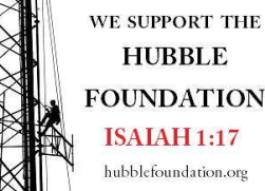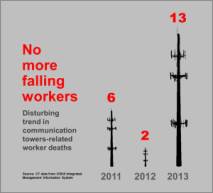Podcast: Play in new window | Download | Embed
Subscribe: Apple Podcasts | RSS
Hello all,
I wanted to go over 4 things today. Something that you hear about tower work is all the risks. What about the things that most workers live in, like their truck. I thought it might be fun for all of you to talk about what you drive. When you do tower work your truck is your office, you live in it. You probably had one that you loved and one that you hated. I have a survey so I expect you to let me know in a sentence or 2.
Subscribe to the podcast!
Hurry, write a review on iTunes or Stitcher today!
I also want to give you some links to gain access to the rope experts, just to let you know what is going on. IRATA and SPRAT are excellent resources for not only rope access workers but to teach climbers more about rope and controlled descent. We can all learn from what they have to share.
Finally 2 more things! It’s hot out there! Be aware of your body’s needs. Stay hydrated and keep your work mates hydrated. This ties into the finally subject, and that is near misses that are never reported.
Truck, specifically your work truck. Do you have a favorite work truck for tower work? Not your personal vehicle, but your work truck. If you’re like me you had several throughout your career. I have a survey, it’s simple! Just tell me your favorite work truck and your most hated work truck. Don’t just tell me the make and model but give me a 1 sentence response why you loved or hated it.
Let me tell you mine! My favorite was a Ford F150, great truck because it was really nice inside, nice ride, could handle hauling over 1,000 lbs of steel, and was reliable. It was so reliable. That is the one truck that never broke down on me. I had 2 trucks that didn’t break down ever, this one and I had a Nissan Armada, SUV, that is another awesome vehicle that I used for engineering work.
I really hated a Chevy 1500 I had, you know why? It would break down on Friday nights when I was on my way home. Not once, not twice, 3 times in 2 years on a Friday night while I was on my way home. I really hated that truck! I had a Ford Explorer which had transmission problems, but even that truck ran. The Chevy 1500 had its gas pump, in the gas tank, that would fail regularly. For the mechanic to repair it he would have to drain and drop the gas tank because the pump was in the tank. What a stupid design! This truck helped me decide that I would never buy another Chevy, but hey, that’s me.
http://wade4wireless.polldaddy.com/s/trucks-in-tower-work
Ropes, we really need to know more about ropes. This is an update from IRATA. IRATA, International Rope Access Trade Association. Why would a tower worker care? If you’re asking that, then maybe you should look for a new career. Climbers use ropes every day, lanyard, rigging, safety, controlled descent, hoists, and more. You all should be paying attention to attention to what this industry is saying and we should quickly partner with them. They have updates on their site, IRATA, offering several PDF documents that should be of interest to you.
Also in the realm of ropes you should be paying attention to what SPRAT is doing. SPRAT, Society of Professional Rope Access Technicians. Web site is here, SPRAT and they just had a meeting in Colorado that I am looking to see what they talked about. They have standards to download at http://sprat.org/publications/standards/ and white papers at http://sprat.org/publications/whiteletter/ that have good information. I suggest that you take a look to know what you are missing. Specifically this,”Safe Practices for Rope Access Work”, which you to review.
Heat is something that many workers are dealing with this time of year. I would like to quote Art Seely, who happens to be the CEO at Safety One International Training and a senior paramedic, http://safetyoneinc.com/ for all of those wondering about this guy. Thank you Mr. Seely! He sent me this in LinkedIn on a discussion we had on heat exhaustion of the worker that needed to be rescued recently. Per Arthur Seely, “Wade, Just a guess but I would put $20 on the fact the climber was dehydrated! The big difference between climbing in the summer (or in Florida any time of year) and climbing in the winter is that although dehydration occurs in both scenarios in the hot environment perspiration causes the dehydration which throws the electrolyte balance in the blood plasma off very quickly resulting in nausea, cramps, weakness, postural hypotension etc, A summer climber needs fluid with electrolytes such as a diluted 50% Gatorade mixture to drink at 10 minute intervals. The only disadvantage to 50% diluted Gatorade is the stomach “sees” the nutrients in the solution and immediately passes the fluid on to the small intestine where the absorption rate is only 1/3 as fast as if the fluid stayed in the stomach. With pure water the fluid stays in the stomach and is more quickly passed to the blood stream. Once in the blood stream the rehydration progresses next to the cells and finally to the interstitial spaces. The point of mentioning that is that even though a climber feels better after rehydrating from serious dehydration he should wait at least 12 hours to resume any significant work. In winter climbs the majority of the fluid loss is through the surface of the lungs which unlike perspiration does not upset electrolyte balance and water is a great substitute to drink before, during and after the climb… In either case once you have a victim on a tower or on the ground the initial attempts at “fluid resuscitation” should always utilize water at close to body temperature. As with all victims they must be able to hold the fluid container and drink from it themselves, do not attempt to pour it into their mouth as vomiting and aspiration resulting in a delayed bacterial pneumonia is a likely result and that can easily be fatal without prompt hospitalization. Once the victim’s symptoms start to improve then if they were in a hot environment you can start with Gatorade at 50% or 100% concentrations. A couple of instructors at Safety One are working on heavily modifying an insulated 3 L Camelback to safely attach to a standard harness, I’ll let you know when they have it “perfected”. At that point Safety One will be having a “garage sale” of about 50 different slightly used and damaged Camelback type hydration carriers from all over the world!! LOL!”
I will have more on heat in another post, this could go on for hours but let me send you off with some links, California law, http://www.dir.ca.gov/DOSH/HeatIllnessInfo.html, and the Training Advisor, http://trainingdailyadvisor.blr.com/category/workplace-safety/?source=TDA&effort=18&funcode=QT10&utm_source=BLR&utm_medium=Email&utm_campaign=TDAEmail both have some good information. Basically, if you are on the tower remember to stay hydrated. If you are on the ground remember to stay hydrated and remind the guy in the air to stay hydrated and send the climber fluid on a regular basis. Be smart and pay attention so no one gets hurt!
Finally, the near misses conversation. I was reading the post of my friend Kevin Carter, seen HERE about how no one reports near misses. Go ahead and read his article, then come back if it’s easier. Basically Kevin talks about how tower workers, rarely, if ever, report near misses when no one gets hurt. Why would they, after all, no one got hurt. Well, maybe this is how we learn. The problem is that in any company you get penalized for the accident regardless if someone gets hurt or not. Safety is better than it’s ever been, and yet this year and last year are the worst ever for deaths! Did you read that? The worst for death rate in the tower industry. So what can we do? Well, I think I have an answer, If you have a story you would like to tall, I can do 2 things. I can write about it, keeping your name confidential, I could record it, but I won’t disguise your voice, or you can email me and let me know what it is. I would like to put a collection of stories together for a post, but only if you want to talk about them.
Sharing near misses in this industry is a lesson for future workers. I think it would be valuable content that should be shared with everyone. However, I know it’s embarrassing or it may be your job. So I think if you would share, I will print it and keep your name, company, and location out of the article. My information is below. I know that you probably don’t want to do this, but it really is a responsibility to share the lessons learned. So if you share a story, then make sure you share what you did wrong and what you did next time to make it right. Got it?
I understand why workers don’t like to report things like this, because the safety manager would want to shut the job down, do drug testing, and make everyone write-up an accident report. That hurts the schedule, creates delays, and is a real inconvenience. I get it, just make a note and the crew on site knows not to do something like that again. That is where the mentoring program comes in handy because the experienced climber can share the story with the newer climber. If you are new, don’t judge, listen and learn.
OK, we covered a lot in this post. Let me know about your favorite and hated trucks! Read up on rope access and learn. It’s more than being well-rounded, it’s being prepared! Read up on heat, hydration, and looking out for your work mates so that you all get home alive. Finally, pay attention to near misses and share those stories with me, let me know what they are so I can share them. This is your chance to share your knowledge with others in the industry. Help a fellow tower worker out. Maybe your story will save someone’s life!
By the way, I am planning to put out some more books, this time on scopes of work, Bill of materials, and other useful information for the workers. Let me know what you think.
Other information!
Remember that the Hubble Foundation needs your support. They help any climber in need, so remember that when you need help and if you can help! Show you care for the families of the fallen and the fellow climbers in need. They still have tickets to the car giveaway! Support Hubble, honor the fallen, and maybe win a Mustang! By the way, how much did you give today?
I am working on 2 new projects, a new book that outlines my different jobs in the industry and a library of reference material that you can access quickly to take to the site. I want to see you make the site safer with quick reference material. If you have any idea of what you need out there let me know. Show me you care, Facebook, wade4wireless@gmail.com or leave a comment or leave a message at 510-516-4283
My Books on Kindle:
My PDF books on Sellfy, Pay with PayPal:
My PDF books on GumRoad, Pay with Credit Card:
Whistle blower information;
http://www.mondaq.com/article.asp?articleid=330216
http://www.regulations.gov/#!documentDetail;D=OSHA-2011-0540-0001











